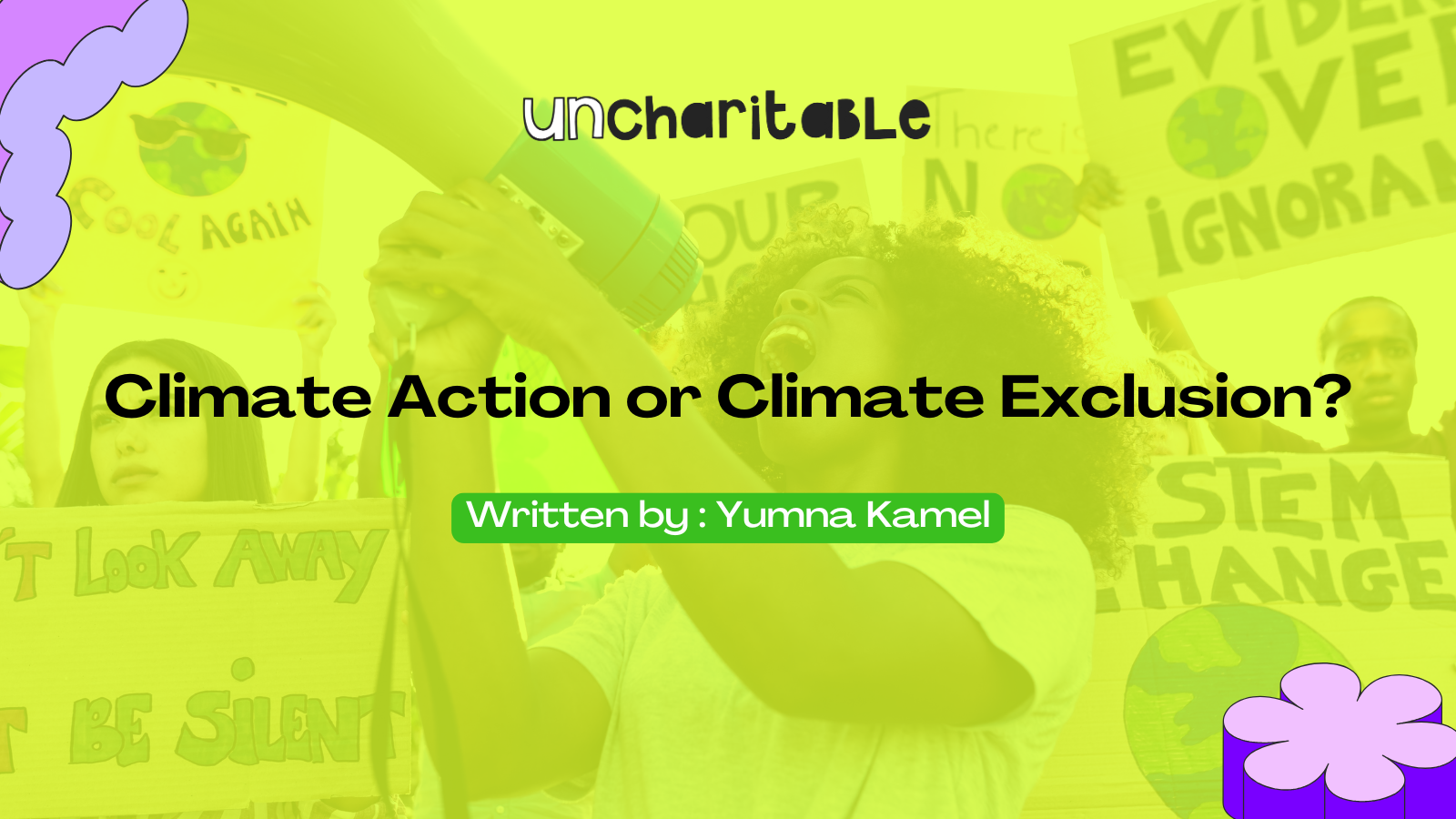Climate Justice or Climate Exclusion? By Yumna Kamel
Yumna Kamel is the Co-Founder and Executive Director of Earth Refuge, the first legal think tank focused on climate mobility.
Her work is centred upon community legal education, with the goal of making justice accessible to those most affected by climate displacement. At Earth Refuge, Yumna leads the organisation’s advocacy, research, and education initiatives — including the creation of accessible legal resources designed to support communities and practitioners navigating these complex issues. Yumna has a background in refugee and immigration law, and was previously the Senior Legal Education Officer at the London-based charity, Right to Remain.
Yumna serves on the Advisory Board of the Global Center for Climate Justice and the Advisory Board of Dhaqan Collective, an art and community initiative centring Somali diasporic experiences through food, textiles, and sound.
Climate Justice or Climate Exclusion?
“I love your costume!”, an obtuse delegate squealed as she squeezed the arm of an Indigenous Zenú attendee dressed in traditional attire.
I winced as I entered the seminar room and witnessed this exchange (can it be called an exchange?) on the second day of a major UN climate change summit I attended a few years ago. The summit had a stated focus on Indigenous rights.
The event was a grand display of global solidarity – or so it seemed. Indigenous leaders from across the world were invited to share their experiences and insights on the impact of the climate crisis upon their land, livelihoods, and their very existence. Yet, when they arrived, many found they could not participate meaningfully. The organisers had failed to provide interpreters for many of the roundtables and seminars. As a result, these leaders were silenced, their voices rendered literally unheard in a conversation that was supposed to centre them.
This incident was not an isolated oversight. It was emblematic of a deeper issue within climate justice spaces: the persistent exclusion of those most affected by climate change. It raises a fundamental question: when we talk about climate justice, whose voices are we really listening to? Who is allowed to meaningfully participate in the climate discourse, and who is merely brought in for optics?
Those who carry the water don’t sit at the table
When it comes to my own work, climate displacement is often discussed in abstract terms, but the reality is deeply personal. I distinctly remember the founders of Dhaqan Collective – an incredible art collective who use everyday materials, cassette tapes, food, and textiles, to create spaces of community, joy and healing that centre the full range of Somali diasporic experiences – speaking at a funder-run climate event in London and asking the room full of third sector professionals and grantmakers to consider who is truly footing the bill of the climate crisis. They answered the question for us: it’s the Somali nurses, the cleaners, the security guards and the taxi drivers, who (perhaps while shuttling climate CEOs from event to event?) are sending remittances back home to families, year after year. These individuals are on the front lines of climate change, yet their experiences are seldom acknowledged in policy discussions.
It is no secret that the impacts of climate displacement are disproportionately felt by Black, brown, and Indigenous communities. These groups – we – are not only more likely to be displaced but also less likely to have a seat at the table when decisions are made. The irony is stark: those who bear the brunt of climate change are often excluded from the conversations about how to address it.
As an Arab, Muslim, woman founder of a small organisation focused on climate displacement, I have experienced firsthand the inequities within the nonprofit sector. While large, predominantly white-led organisations receive the majority of funding, smaller, grassroots organisations led by people of colour are often expected to contribute their expertise for free. Invitations – demands, even – to speak on panels or review reports are common, but financial compensation is rare, and in most cases must be explicitly requested. I can’t count the number of times I’ve opened up my LinkedIn inbox to persistent and eager requests for interviews, consultations, and speaking engagements with no consideration for my time or compensation for my ‘expertise’ which the sender so requires. Each time, I sigh “allow me,” as I click the Mark Unread button.
This dynamic reflects a broader pattern of racial capitalism within the climate justice movement. Just as natural resources are extracted from their land, the labour of people of colour is extracted without adequate recognition or remuneration, reinforcing existing power imbalances. The sector’s commitment to justice is called into question when those most affected by climate change are not supported equitably.
Inclusion without power is tokenism
The UN conference incident underscores this critical point: providing a platform without the means to participate meaningfully is not inclusion, it is exclusion in disguise. True inclusion requires not only a seat at the table but also the resources and support to engage fully, and to be taken seriously.
Yet this is exactly what we continue to see in global and local climate discourse. Indigenous and frontline leaders are invited to attend events that are prohibitively expensive (tickets, visa applications, travel and accommodation), with limited accessibility support, no pre-session preparation, no translation, and hardly any pathways for sustained engagement. When these leaders do make it into the room, the power to shape agendas, influence outcomes, or steer funds remains in the hands of elite institutions and governments. Symbolic visibility is not the same as political agency.
True change
To move from performative allyship to structural equity, several practical actions must be taken by institutions and funders in the climate space. For instance:
Allocate a fixed percentage of all climate funding directly to grassroots, BIPOC-led organisations, with simplified application processes and multi-year, unrestricted grants. Funders must actively divest from extractive funding practices that reward bureaucracy over lived experience.
At all international and national climate events (both in person and online), interpretation services must be non-negotiable. This includes simultaneous translation, sign language, and materials in multiple languages – with budget lines explicitly dedicated to these services.
Introduce mandatory compensation frameworks for consultations, panels, or advisory roles involving frontline leaders. If their knowledge is valuable enough to be sought, it must be valued enough to be paid.
Include community-led representatives in decision-making structures of third sector organisations, charity boards, and climate coalitions. These roles should not be advisory or symbolic but hold actual power and influence over budget decisions.
Organisations that claim to centre equity must publish transparent annual reports detailing demographic breakdowns of staff, leadership, funded partners, and paid versus unpaid contributors. Public transparency is the first step to accountability.
Climate justice does not exist in a vacuum. It intersects with housing, immigration, work rights, and racial justice. Building alliances with movements led by migrants, workers, and Indigenous land defenders creates a more resilient, holistic strategy for systemic change.
These solutions are not aspirational. They are practical, measurable, easy to implement, and overdue. The problem is not a lack of knowledge, but a lack of will.
Moving forward
Achieving true climate justice requires a fundamental shift in how we approach the issue. It involves recognising the leadership and expertise of those most affected by climate change and ensuring they have the resources and support to lead the response. It also demands a hard look at the structures that maintain inequality – from donor hierarchies to international climate governance.
The climate movement will continue to have a shortsighted view if it is not led by those who have never had to evacuate their homes, bury livestock in drought-struck land, or scavenge for clean water. Leadership must be redefined away from credentials and toward credibility rooted in lived experience. Climate policy designed without displaced communities is not only incomplete, it’s harmful.
We must ask: are we building a climate-resilient world for everyone, or merely reinforcing the status quo in greener packaging?
The path to climate justice is not through grand conferences or lofty declarations but through concrete actions that empower those most affected by climate change. It requires dismantling the structures of exclusion and building a movement that is truly inclusive and equitable.
This also requires a deep reckoning with whiteness within the climate movement largely led by and in the Global North. Until the nonprofit and climate sectors grapple with their own complicity in perpetuating colonial power dynamics – through funding practices, hiring patterns, and public narratives – real progress will remain out of reach.
We cannot build a climate-just future unless we centre those who are already paying the price – not as case studies, not as background voices, but as co-architects of solutions.
The truth is simple. There is no climate justice without racial, economic, and migration justice.

